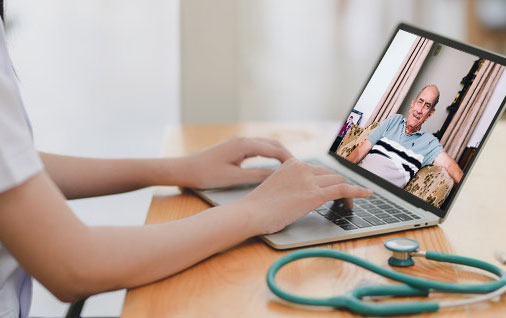As the pandemic forces the world to change, doctors and patients have turned to virtual care. For people with dementia, the benefits of telemedicine — delivering clinical services remotely — is an adjustment, but one that has benefits: Sparing people trips to the doctor’s office, which can be costly, disruptive and stressful. It also has its drawbacks. Patient advocate Roseanne Geisel explores its impacts and offers guidance.
Is there a doctor in the house? That question has been asked in emergency situations and in comedy sketches. Most of us don’t have a doctor in the house, but telemedicine is enabling us to consult one without leaving home.
I have anecdotal evidence about how telemedicine has worked for my patient advocacy clients and for myself during the Coronavirus quarantine. It is important to remember that many providers hadn’t planned on turning office visits into telemedicine appointments, so there wasn’t much prep time.
The telemedicine trend predates the coronavirus pandemic, but has been accelerated by it, according to Scott Galloway, a professor at New York University Stern School of Business. “We’re learning through this crisis that health care and education can be delivered without the constraints of geography,” Mr. Galloway said during an April alumni lecture at the University of California Berkeley Haas School of Business. He calls it “the great dispersion,” noting that the vast majority of people who contracted COVID-19 were identified, treated and recovered without ever going to a medical office or hospital.
Health care delivery through telemedicine has already been used in primary and specialty care, psychiatric and behavioral health, remote patient monitoring and stroke care, said Stewart Levy, founder and president of HealthWell Solutions, a health management company. HealthWell develops health and wellness programs and technology, including telemedicine and digital health applications, for corporations, hospitals and other organizations. “Many barriers to wide-scale adoption are going away,” Mr. Levy said during a pre-Coronavirus webinar presentation to an advocacy group.
The Centers for Medicare and Medicaid Services is now reimbursing physicians and other providers for telemedicine visits, and technological advancements are enabling more services to be offered outside the medical office or hospitals, he said.
Mr. Levy prefers to use the term digital health, as this is not just about talking with the health care provider over the telephone. He talks about five types of digital health:
- Live video, where patient and provider are seeing each other
- Store and forward, in which x-rays and medical imaging are completed and stored, then sent to a physician or other health care provider
- Mobile health, which includes monitoring chronic conditions and transmitting data to healthcare providers using personal home assistants like Alexa or Google Home
- Electronic consults in which health care providers have peer discussions on line
- Remote patient, similar to mobile health, where a patient may go to a technology-equipped origination site and communicate with a medical professional at a distant site.
A recent supplemental benefit under Medicare Advantage plans is reimbursement for nonclinical home caregivers who help with remote patient monitoring using the technology in a patient’s home to transmit data to healthcare providers, Mr. Levy said.
From my experience during the coronavirus pandemic, online medical appointments are a great option for certain health care situations and still have limitations in others. Both technology and comfort levels with e-visits are likely to improve with time.
I think psychiatric care and behavioral health work well via online sessions that include video as well as audio. It occurred to me that perhaps people who need mental health-related medical care may be less resistant if they could use a telemedicine approach. I have heard therapists say that it takes a little adjustment, because it is not as easy for the therapist or patient to read each other’s body language.
Other functions that work well via telemedicine are reviewing test or imaging results or getting a second opinion once the necessary reports have been sent to the physician who is asked for a consultation.
Some things do not work as well. It is a challenge to show swollen ankles or an outbreak of eczema in an e-visit.
Just as patients should prepare questions for the doctor and bring all necessary reports to a medical office visit, preparation also makes a telemedicine visit more effective. First of all, the patient must be equipped with the technology, usually a laptop or iPad and Wi-Fi, to connect to the visit and know how to use it. Patients who are, for example, in an assisted-living facility and do not have their own technology should check in advance whether there is a laptop or another device to use and someone to help if necessary.
If the health care provider will want to know what your blood pressure is and you don’t have an at-home blood pressure cuff, perhaps you could arrange to purchase or borrow one prior to the appointment. Residential communities could have a nursing assistant take the blood pressure and provide the number to the provider.
The future of digital health will likely make virtual clinics or medical carts, which are mobile workstations with the necessary technology, more widespread in corporate offices, retail outlets and other places. Traditional medical facilities may extend their geographic reach with a hub and spoke system featuring virtual clinics that enable the patient to see a doctor at a distant site, Mr. Levy said.
An in-person relationship with a trusted medical professional remains very valuable to a person’s health and well-being. Nonetheless, the benefits of telemedicine for patients and healthcare professionals will likely outweigh the disadvantages for many patients in certain situations.
Roseanne Geisel is the founder of Geisel Advocacy for Patients. This article is part of the Patient Advocacy series, in which patient advocates discuss the role of an independent patient advocate.







